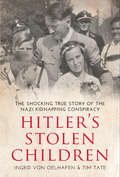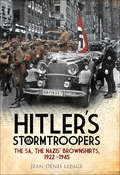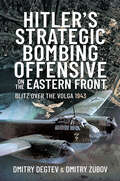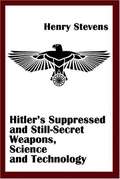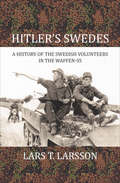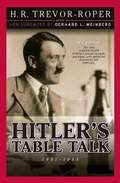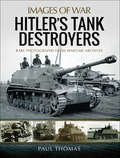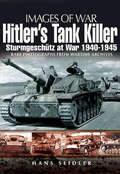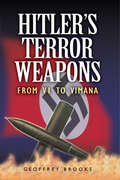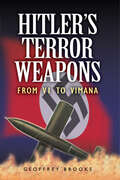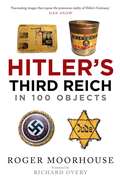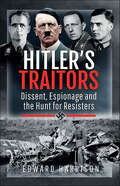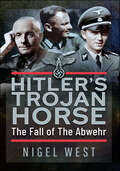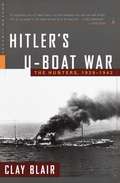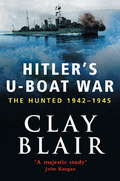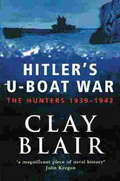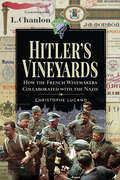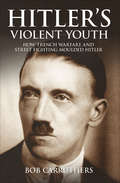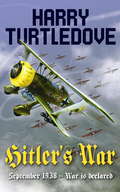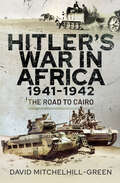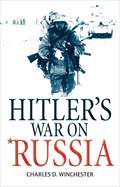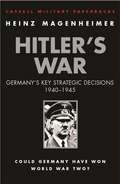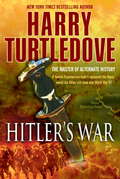- Table View
- List View
Hitler's Stolen Children: The Shocking True Story of the Nazi Kidnapping Conspiracy
by Tim Tate Ingrid von OelhafenHitler’s Stolen Children is a powerful, first-person account of being at the heart of one of the Nazi’s cruelest and most obscene experiments—the Lebensborn program to create a new Aryan master race. In 1942, when she was nine months old, Erika Matko was stolen from her family in St. Sauerbrunn in what was then Yugoslavia and transported to Germany to be “Germanized.” She was chosen because, unlike her older brother and sister, she was blond and blue eyed, and had passed a medical racial examination that classed her as Aryan. Lebensborn then farmed her out to politically vetted German foster parents. Renamed Ingrid von Oelhafen, she grew up believing she was German. Then, one day, friends of her foster family revealed the truth about her origins. This was the beginning of a life-long quest to discover the truth about her birth and the Lebensborn program. It was a journey that would take her across Germany, uncovering the terrible secrets of Lebensborn—including the kidnapping of up to half a million babies like her and the deliberate murder of those deemed “sub-standard”—and back to the village where she was born. But here she would be faced with something even more painful: a woman who for more than seventy years had been using her name—and living her life.
Hitler's Stormtroopers: The SA, The Nazis' Brownshirts, 1922–1945
by Jean-Denis LepageThe Sturm Abteilung der NSDAP (SA, assault battalion of the Nazi party) created in August 1920 were squads of strong arms intended to protect the Nazis meetings, to provoke disturbance, to break up other parties meetings, and to attack and assault political opponents as part of a deliberate campaign of intimidation. After 1925 the name Braunhemden (Brownshirts) was also given to its members because of the colour of their uniforms. Under the leadership of Hitlers close political associate, Ernst Rhm, the SA grew to become a huge and radical paramilitary force. This book answers several questions concerning the SA. How did the SA become a national movement? What was the relationship between Rhm and Hitler? What role did the SA play in providing Hitler with the keys to power? After the seizure of power by the Nazis on January 30, 1933, what was the function of the Brownshirts? Why did the brutal and scandalous Ernst Rhm stand in Hitlers way? What became of the SA after the bloody purge of June 1934, the notorious Night of the Long Knives?
Hitler's Strategic Bombing Offensive on the Eastern Front: Blitz Over the Volga, 1943
by Dmitry Degtev Dmitry ZubovGermany was never able to match the power of the Allied air forces with their great four-engine bombers, the Lancasters, Liberators and Flying Fortresses. Indeed, many have ascribed the defeat of Germany in the Second World to its lack of a strategic bombing force. There were, though, two occasions when the Luftwaffe’s twin-engine bombers undertook strategic objectives on a large scale. The first of these was the ‘Blitz’ of 1940-1941, in which the Luftwaffe attempted to wreck Britain’s industrial and military capacity. The second was on the eve of Operation Zitadelle, a major offensive against Soviet forces in the Kursk salient Hitler’s objective was to replicate the successful Allied mass-bombing of German cities, the Luftwaffe being tasked with destroying the main tank and aircraft production facilities and fuel depots. Hitler saw this as the necessary prelude to weaken the Russians before the ‘decisive’ onslaught of Zitadelle. The aerial operation, Carmen II, lasted for a month and covered a huge target area from the Rybinsk reservoir to the Caspian Sea. For these complex and risky night missions, all the Ju-88 and ??-111 bombers available to Hitler in the East were employed. The authors have collected a huge amount of factual material, reconstructing all the details of this little-known campaign, which was the largest operation Luftwaffe on the Eastern front. This book opens a completely new page in the history of the German air war and provides a comprehensive investigation into the nature of the targets attacked, the degree of damage suffered by the Soviet military machine, and how this affected Operation Zitadelle. The descriptions of the dangerous missions carried out by Luftwaffe as part of this operation are presented in great detail and all these exclusive facts are complemented by a large number of unique photos and documents.
Hitler's Suppressed and Still-Secret Weapons, Science and Technology
by Henry StevensNazi technology extended far further than has generally been acknowledged, in fact to almost unfathomable levels! Yet conventional historians have absolutely failed to provide an adequate picture of the technology, science and weaponry of the Third Reich. Was it government intervention, peer skepticism or just plain intellectual laziness which caused these historians to stop digging?
Hitler's Swedes: A History of the Swedish Volunteers in the Waffen-SS
by Lars T. LarssonSweden was neutral during the Second World War, but despite this, thousands of Swedes wanted to participate in the war—the largest group in Finland, where over 10,000 Swedes applied to fight against the Red Army. Another much smaller group, which saw action against the same enemy, was the Swedish SS volunteers. While the Danish and Norwegian SS volunteers are fairly well known today, their Swedish counterparts remain more unknown. Still, they saw action on both the Eastern Front and NW Europe, and participated in some of the bloodiest clashes: the initial stages of Operation Barbarossa, the winter of 1941/42, the battles of Kursk, Arnhem, Normandy, Narva, the Warsaw uprising, the Cherkassy and Kurland pockets and, finally, the end in Berlin. Compared to many other groups of volunteers, there was never an official recruitment drive in Sweden, which is why only some 180-200 men enlisted. Those who wanted to recruit themselves often had to make their way to the occupied countries—a fact that makes those Swedes who joined the SS volunteers in the truest sense. As such, this book is as much a history about the units, which the Swedes served in, as it is a story about the individuals themselves. It also asks, who were they? What motivated them? What did they experience and how did their service end? With the help of diaries, letters, interviews, police interrogations and German documents from both private and official archives, the history of the Swedish SS volunteers is reconstructed. The main focus is on those who served at the front, including volunteers in the 'Wiking', 'Nordland', 'Nord' divisions, minor units such as the Den Norske Legion, SS-Panzer-Brigade 'Gross' and the war correspondents of the SS-Standarte 'Kurt Eggers'. Also included are the Swedish non-combatants in the SS, such as the desk clerks within the SS-Hauptamt and security service personal of the RSHA. The book lets us follow individuals such as Hans Lindn, who was the first named Swedish volunteer to fall in action aged barely 19 years old; the unpopular Swedish SS officer Gunnar Eklf; Elis Hglund, who after several years on the Eastern Front deserted and returned to Sweden; Gsta Borg, who volunteered for the SS a second time as he was denied the chance of becoming an officer in Sweden; and Karl-Axel Bodin, the only Swede to be included in the list of suspected criminals at the Simon Wiesenthal Center, who joined the SD in March, 1945. The book includes over 150 photos, everything from civilian photos, portraits from the men's time in the SS, pictures taken in the field, post-war photos and documents. Most are from the private albums of the volunteers and many are previously unpublished. Thoroughly researched from primary sources, and providing plenty of absorbing detail, this book is a valuable addition to the history of the SS, and the men who volunteered to serve in it.
Hitler's Table Talk 1941-1944
by Gerhard L. Weinberg H.R. Trevor-RoperThis is a new edition of a major document from World War II with additional, previously unavailable texts assembled from the stenographic record of Hitler's informal conversations ordered by Martin Bormann. These texts remain the classic collection of Hitler's nighttime monologues with his entourage, covering mostly nonmilitary subjects and long-range plans. Hitler lets his thoughts wander, never failing to provide an opinion on every subject. Additional documents from various archives make this the most complete English-language edition in print.
Hitler's Tank Destroyers: Rare Photographs From Wartime Archives
by Paul ThomasDedicated German antitank vehicles made their first major appearance in the Second World War as combatants developed effective armored vehicles and tactics. Some were little more than stopgap solutions, mounting an antitank gun on a tracked vehicle to give mobility, while others were more sophisticated designs. The book covers the development and technology throughout the war that led to tank destroyers like the Panzerjger I, Sturmgeschtz, Marders, Nashorn. Hetzer, Jagdpanzer, Elefant, Jagdtiger IV and Jagdpanther vehicles being developed.As the war progressed the tank destroyers fire power became more lethal to meet the ever increasing threat against Soviet armor. Larger and more powerful variants entered the battlefield, but due the overwhelming enemy opposition they were compelled not only to attack armor, but to support ground troops too. This comprehensive account covers all the Nazis mobile antitank vehicles in words and images.
Hitler's Tank Killer: Sturmgeschütz at War, 1940–1945 (Images of War)
by Hans SeidlerSturmgeschtz III was originally designed as an assault weapon, but as war progressed it was increasingly used in a defensive role and evolved into an assault gun and tank destroyer. By 1943 its main role was providing anti-tank support to the units in its area of operation. This consequently led to many StuGs being destroyed in battle. Nonetheless they were very successful as tank killers and destroyed, among others, many bunkers, pillboxes and other defenses. While not considered to be a true tank because it lacked a turret, the gun was mounded directly in the hull, with a low profile to reduce vehicle heights, and had a limited lateral traverse of a few degrees in either direction. Thus, the entire vehicle had to be turned in order to acquire targets. Omitting the turret made production much simpler and less costly, enabling greater numbers to be built. Most assault guns were mounted on the chassis of a Panzer III or Panzer IV, with the resultant model being called either a StuG III or StuG IV respectively. The StuG was one of the most effective tracked vehicles of World War II, and over 10,000 of them were eventually produced.
Hitler's Tank Killer: Sturmgeschütz at War, 1940–1945 (Images of War)
by Hans SeidlerSturmgeschtz III was originally designed as an assault weapon, but as war progressed it was increasingly used in a defensive role and evolved into an assault gun and tank destroyer. By 1943 its main role was providing anti-tank support to the units in its area of operation. This consequently led to many StuGs being destroyed in battle. Nonetheless they were very successful as tank killers and destroyed, among others, many bunkers, pillboxes and other defenses. While not considered to be a true tank because it lacked a turret, the gun was mounded directly in the hull, with a low profile to reduce vehicle heights, and had a limited lateral traverse of a few degrees in either direction. Thus, the entire vehicle had to be turned in order to acquire targets. Omitting the turret made production much simpler and less costly, enabling greater numbers to be built. Most assault guns were mounted on the chassis of a Panzer III or Panzer IV, with the resultant model being called either a StuG III or StuG IV respectively. The StuG was one of the most effective tracked vehicles of World War II, and over 10,000 of them were eventually produced.
Hitler's Terror Weapons: From VI to Vimana
by Geoffrey BrooksThis is the story of the Terror Weapons developed by Hitler and Nazi Germany that were intended to be unleashed with devastating effect on the rest of the World. The book charts the development of the V rockets and their successes against allied targets. It then goes on to look at the even more sinister deadly weapons that Hitler was planning and developing, but fortunately did not succeed in producing. Hitler's Terror Weapons tells of the desperate efforts of the Nazis to produce war-winning weapons, and the measures taken by the Allies at the high levels to frustrate them in their aim.
Hitler's Terror Weapons: From VI to Vimana
by Geoffrey BrooksThis is the story of the Terror Weapons developed by Hitler and Nazi Germany that were intended to be unleashed with devastating effect on the rest of the World. The book charts the development of the V rockets and their successes against allied targets. It then goes on to look at the even more sinister deadly weapons that Hitler was planning and developing, but fortunately did not succeed in producing. Hitler's Terror Weapons tells of the desperate efforts of the Nazis to produce war-winning weapons, and the measures taken by the Allies at the high levels to frustrate them in their aim.
Hitler's Third Reich in 100 Objects: A Material History of Nazi Germany
by Roger MoorhouseHitler's Third Reich is still the focus of numerous articles, books and films: no regime of the twentieth century has prompted such interest or such a body of literature. Collated and presented by one of the world's leading historians of Nazi Germany and illustrated with photographs throughout, this book is an accessible, compelling and often revelatory guide to the Third Reich. Ranging from documents and postcards to weapons and personal effects, these objects include Pervitin, Hitler's Mercedes, Hitler's grooming kit, the Messerschmitt 262, the Luger pistol, the Tiger Tank, Eva Braun's lipstick case, the underpants of Rudolf Hess, and, of course, the Swastika and Mein Kampf.
Hitler's Traitors: Dissent, Espionage and the Hunt for Resisters
by Edward HarrisonThis collection of vivid essays examines some of the most fascinating aspects of the German resistance to Hitler. It includes the first translations into English of pioneering studies on the role of a leading Nazi in the July Plot, the flight of Rudolf Hess to Britain and the vigorous controversy over Hugh Trevor-Roper’s investigation of Hitler’s death. The book also explores vociferous Catholic dissent in Franconia and the conspiracies against the Third Reich of the revolutionary New Beginning movement. Through the study of important personalities and dramatic events this book explores the possibilities and challenges faced by Germans in attempts to frustrate and defy Hitler’s tyranny.
Hitler's Trojan Horse: The Fall of the Abwehr, 1943–1945
by Nigel West"Nigel West has presented the most complete account of the Abwehr to date. It will serve as a valuable reference work." — Studies in IntelligenceAs the Second World War progressed and defeat for Hitler’s Third Reich in all theatres became ever more certain, the tight Abwehr network, built so effectively by its head, Admiral Canaris, began to unravel. High-level defections to the Allies and bitter disputes with the Sicherheitsdienst (SD) added to a collapse in morale. Most notably was the increasing opposition within the officer ranks of the Army to Hitler fermented by Canaris and his deputy Generalmajor Hans Oster. The final years of the Abwehr were marked by the Abwehr’s efforts to undermine the regime, which came to a bloody conclusion following the Valkyrie assassination attempt of 20 July 1944. This saw the arrest of many Abwehr officials and the execution of Canaris and Oster. In this penetrating study of the final years of the Abwehr, Nigel West, a world-renowned specialist in the field, pieces together the gradual decline in the organization’s role and importance with Hitler and his acolytes paying little heed to reports that were increasingly cautionary. Among the many previously undisclosed stories are details gleaned from recently opened files which tell of a hitherto unknown spy-swap. This was the exchange of Berthold Shulze-Holthus, a German spy detained in Iran, for Ferdinand Rodriguez, a British radio operator captured in France. This was the only such exchange that took place during the whole of the Second World War – though the fact that the swap took place at all suggests that a previously unsuspected degree of communication existed between the Allies and Nazi Germany. Perhaps most tantalizingly of all, is the new night light thrown upon the role the British Secret Intelligence Service, MI6, had, in league with the Abwehr, in the Valkyrie bombing which almost killed Hitler.
Hitler's U-Boat War
by Clay BlairClay Blair's best-selling naval classic Silent Victory: The U.S. Submarine War Against Japan, is regarded as the definitive account of that decisive phase of the war in the Pacific. Nine years in the making, Hitler's U-boat War is destined to become the definitive account of the German submarine war against the Allies, or "The Battle of the Atlantic."It is an epic sea story, the most arduous and prolonged naval battle in all history. For a period of nearly six years, the German U-boat force attempted to blockade and isolate the British Isles, in hopes of forcing the British out of the war, thereby thwarting the Allied strategic air assault on German cities as well as Overlord, the Allied invasion of Occupied France. Fortunately for the Allies, the U-boat force failed to achieve either of these objectives, but in the attempt they sank 2,800 Allied merchant ships, while the Allies sank nearly 800 U-boats. On both sides, tens of thousands of sailors perished.The top secret Allied penetration of German naval codes, and, conversely, the top secret German penetration of Allied naval codes played important roles in the Atlantic naval battle. In order to safeguard the secrets of codebreaking in the postwar years, London and Washington agreed to withhold all official codebreaking and U-boat records. Thus for decade upon decade an authoritative and definitive history of the Battle of the Atlantic could not be attempted. The accounts that did appear were incomplete and full of errors of fact and false interpretations and conclusions, often leaving the entirely wrong impression that the German U-boats came within a whisker of defeating the Allies, a myth that persists.When London and Washington finally began to release the official records in the 1980s, Clay Blair and his wife, Joan, commenced work on this history in Washington, London, and Germany. They relied on the official records as well as the work of German, British, American, and Canadian naval scholars who published studies of bits and pieces of the story. The end result is this magnificent and monumental work, crammed with vivid and dramatic scenes of naval actions and dispassionate but startling new revelations and interpretations and conclusions about all aspects of the Battle of the Atlantic. The Blair history will be published in two volumes. This first volume, The Hunters, covers the first three years of the war, August 1939 to August 1942. Told chronologically, it is subdivided into two major sections, the War Against the British Empire, and the War Against the Americas. Volume II, The Hunted, to follow a year later, will cover the last years of the naval war in Europe, August 1942 to May 1945, when the Allies finally overcame the U-boat threat.Never before has Hitler's U-boat war been chronicled with such authority, fidelity, objectivity, and detail. Nothing is omitted. Even those who fought the Battle of the Atlantic will find no end of surprises. Later generations will benefit by having at hand an account of this important phase of World War II, free of bias and mythology.From the Hardcover edition.
Hitler's U-Boat War: The Hunted 1942-45 (Volume 2)
by Clay BlairThe second and final volume of the definitive account of the German submarine war.Acclaimed on its publication in 1997 ('should become the standard history of the Unterseeboote' - Washington Post) volume one of Clay Blair's magnum opus is here followed by volume two, The Hunted covering 1942-45. In this volume the fortunes of the German navy are completely reversed - due in no small part to Allied codebreaking - and they suffer perhaps the most devastating defeat of any of the Germany forces. destroying their submarine service entirely.Blair has been at work on this history for nine years since the British and American governments began to release official WWII records in the 1980s. Blair himself served in submarines in combat in WWII. He chronicles the U-Boat war with authority, fidelity, objectivity and extraordinary detail. He also writes vivid and dramatic scenes of naval actions and dispassionate, but startling new revelations, interpretations and conclusions about all aspects of the Battle of the Atlantic.
Hitler's U-Boat War: The Hunters 1939-1942 (Volume 1)
by Clay BlairA gripping account of the U-Boat war.Already acclaimed on publication in the United States, the U-Boat war is here chronicled with authority, fidelity, objectivity, and extraordinary detail. He also writes vivid and dramatic scenes of naval actions with startling new revelations and conclusions about all aspects of the Battle of the Atlantic.
Hitler's Vineyards: How the French Winemakers Collaborated with the Nazis
by Christophe Lucand“Fascinating. Detailed, well-written, and controversial, Lucand’s history of France and its wine during the Nazi Occupation is an unexpected treat.” —The Wine EconomistDuring the Second World War, French wine was hardly a trivial product. Indeed, following the Fall of France, it proved to be one of the most valuable French commodities in the eyes of the Nazi leaders. In 1940, “Weinführer” (official delegates and wine experts appointed by Berlin), were sent to all the wine regions of France to coordinate the most intense looting that the country had ever seen.Alongside the very ambiguous relationship of the Vichy Regime and the collaboration of many French professionals with the occupiers, this immense program of wine collection was a drama that many would prefer to forget. Now, more than seventy years after the end of the conflict, the time has come to tell the story of what really happened.Following a meticulous investigation and relying exclusively on previously unpublished sources, Christophe Lucand reveals the history of the world of French wine that was subjected to the tests of war, occupation and of all the compromises this entails.“The author has walked the line with sensitivity and provided a balanced review of this very painful time for French winemakers.” —Firetrench
Hitler's Violent Youth: How Trench Warfare and Street Fighting Moulded Hitler
by Bob CarruthersAn Emmy Award–winning author and historian delves into the brutal early life of the man who would become Nazi Germany&’s maniacal dictator. Between 1889 and 1924, Adolph Hitler&’s political outlook was borne out of vicious incidents that heralded the formation of the Sturmabteilung—the notorious SA. Drawing extensively on Hitler&’s own biographical account in Mein Kampf, Bob Carruthers illustrates how these events influenced the future führer&’s worldview and led directly to the Beer Hall Putsch of 1923. Hitler&’s difficult relationship with his cruel father, his harsh experiences in Vienna, and his involvement in the Great War all conditioned him to celebrate violent acts. By Hitler&’s own account, his complete disregard for the consequences of his actions was vindicated by his victories in fierce encounters including beer hall brawls and street battles. Each successive triumph over adversity influenced his decision-making process, imbuing him with a love of violence and culminating in the ill-fated events of November 1924, which saw Hitler imprisoned for the second time. Carruthers also explores the parallel growth of the SA from a small group of fist fighters to a feared paramilitary force along with a comprehensive survey of the violent events between 1920 and 1924, which shaped this infamous political instrument of terror alongside the man who instigated World War II.
Hitler's War
by Harry TurtledoveThe master of alternative history asks the question, 'What would have happened if World War II had started in 1938?'. The results are thrilling.The two sides of the Spanish civil war are still locked in a blood-soaked stalemate. Stalin's purge of the Red Army is barely underway. And Neville Chamberlain - sickened by the arrogance and duplicity of the Germans- does not return from Munich waving the piece of paper that would give the Czech arms factories to Hitler and postpone the war until 1939. On October 1, German tanks cross the Czech frontier, touching off declarations of war from France, from England, from the USSR. Poland, fearing the Russians more than Hitler, declares war on the German side. Soon Fascist Spain attacks Gibraltar, the Japanese army crosses the Manchurian frontier into Siberia . . . and the British Army sets off for France, which has launched a pre-emptive attack on the Rhineland. The war we know as World War II has begun - a year early, in an entirely different way.
Hitler's War in Africa 1941–1942: The Road to Cairo
by David Mitchelhill-GreenAdolf Hitler’s war in Africa arose from the urgent need to reinforce the Italian dictator, Benito Mussolini, whose 1940 invasion of Egypt had been soundly beaten. Of secondary importance to his ideological dream of conquering the Soviet Union, Germany’s Führer rushed a small mechanised force into the unfamiliar North African theatre to stave off defeat and avert any political fallout. This fresh account begins with the arrival of the largely unprepared German formations, soon to be stricken by disease and heavily reliant upon captured materiel, as they fought a bloody series of see-sawing battles across the Western Desert. David Mitchelhill-Green has gathered a wealth of personal narratives from both sides as he follows the brash exploits of General Erwin Rommel, intent on retaking Libya; the Nile firmly in his sights. Against this backdrop is the brutal human experience of war itself.
Hitler's War on Russia
by Charles WinchesterThe Russian front was the decisive theater of World War II with the great mass of the German army and Luftwaffe locked in battle with the Red Army in the largest land campaign in history. On a 1,200-mile front from the Arctic Circle to the Caspian Sea, in baking summer heat and winter temperatures of -40¿C, millions of men and women fought the most vital battle of the war. Had the Germans won in the East, a Nazi victory in World War II would have been almost inevitable.This book examines the German campaign on the Eastern Front, from their first significant defeat at the gates of Moscow in 1941 to the defeat at Stalingrad and the Russian capture of Berlin marking the end of the war in Europe, exploring how Hitler's flawed dream of conquest in the East brought about the end of the Thousand Year Reich - in little over a thousand days.Introduction * Hitler and the Wehrmacht * The Red Army * To the Gates of Moscow * Attack and Counter-attack * Verdun on the Volga: Stalingrad * The Correlation of Forces * The Last Blitzkrieg * The Writing on the Wall * Prussian Roulette * Goodbye to Berlin * Notes * Index * Select BibliographyFrom the Trade Paperback edition.
Hitler's War: Germany's Key Strategic Decisions 1940-45
by Heinz MagenheimerThis is a closely argued and wide-ranging assessment of just how, with so many alternatives open, the German High Command chose the path that led, ultimately, to its own destruction. Heinz Magenheimer examines in detail the options that were open to the Germans as the war progressed. He identifies the crucial moments at which fateful decisions needed to be made, and considers how decisions different from those actually taken could have propelled the conflict in entirely different directions. Using the very latest source material, in particular new research from Soviet Russian sources, the author analyses motives and objectives and considers the opportunities acted upon or rejected, concentrating especially on specific phases of the conflict.
Hitler's War: Germany's Key Strategic Decisions 1940-45
by Heinz MagenheimerThis is a closely argued and wide-ranging assessment of just how, with so many alternatives open, the German High Command chose the path that led, ultimately, to its own destruction. Heinz Magenheimer examines in detail the options that were open to the Germans as the war progressed. He identifies the crucial moments at which fateful decisions needed to be made, and considers how decisions different from those actually taken could have propelled the conflict in entirely different directions. Using the very latest source material, in particular new research from Soviet Russian sources, the author analyses motives and objectives and considers the opportunities acted upon or rejected, concentrating especially on specific phases of the conflict.
Hitler's War: The War That Came Early, Book One (The War That Came Early #1)
by Harry TurtledoveA novel that reveals the human face of war while simultaneously riding the twists and turns that make up the great acts of history, "Hitler's War" is the beginning of an exciting new alternate history saga.
